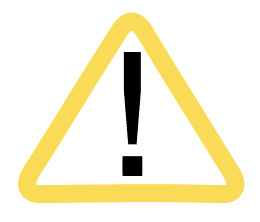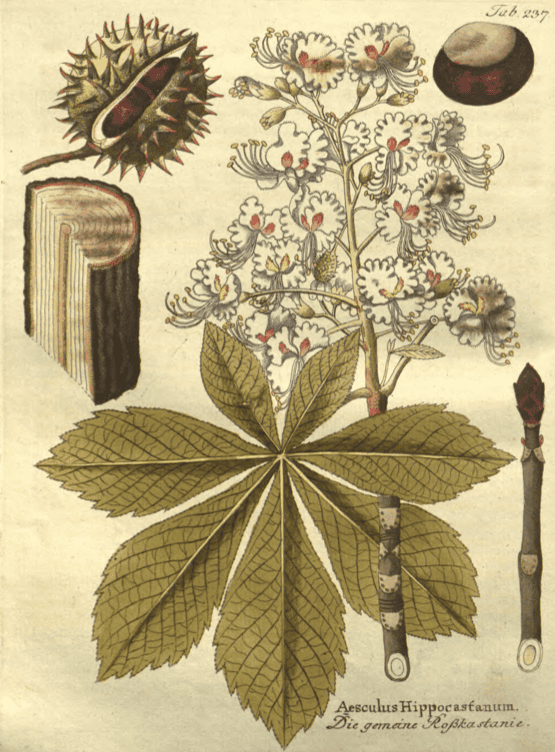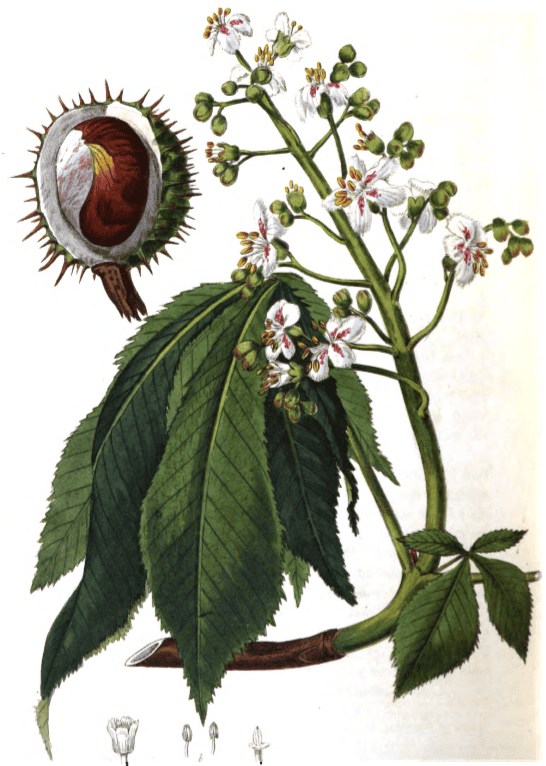Aesculus, Horse ChestnutMandar (Ayurveda)Baloot (Unani) Suo Luo Zi 索罗子 (TCM) |

|

|
 Icones Plantarum Medcio-oeconomico, Vietz, 1806
Icones Plantarum Medcio-oeconomico, Vietz, 1806 Medical Botany, Stevenson & Churchill, Vol II, 1831
Medical Botany, Stevenson & Churchill, Vol II, 1831Botanical name:
Aesculus hippocastanum
TCM uses A. wilsonii, A. chinensis
Parts used:
Seed (ripe fruit without shell), leaf, bark
Temperature & Taste:
Warm, dry. Pungent, Sweet
Cool according to some TCM sources (Bensky). However, other TCM sources regard it as Warm (Chinese Medical Herbology and Pharmacology, Chen & Chen)
Uses:
SEED:
1. Move the Blood, Clears Stasis, Eases Pain: (West)
-Venous insufficiency, Venous conditions, nocturnal leg cramps (Commission E approved)
-pain and heaviness of the legs
-Post-operative soft tissue swelling, Sprains, Backache
-Dysmenorrhea (TCM)
-Hemorrhoids
-Rheumatism, Neuralgia
–Prostate Hypertrophy (Leclerc)
-nodular Acne; Acne with Blood stagnation marked by dark or purplish discoloration
2. Soothe the Liver, Moves Qi, Opens Obstructions: (TCM)
-pain and distention of the Chest, Breast, Ribs or Abdomen
-Premenstrual Breast distention and pain
-Congestion of the Chest from Qi stagnation
-also to direct rising Qi downward (Hiccough, Belching etc,)
-traditionally for Childhood Nutritional Impairment and Malaria (old TCM)
3. Clears Damp, Promotes Urine:
-Edema
4. Kills Worms:
-traditional TCM use, not typically used today
5. Externally:
-oil is applied to Rheumatism
-Varicose veins
LEAF:
1. Move the Blood, Clears Stasis, Eases Pain:
-Deep Vein Thrombosis, Thrombophlebitis
-pain during or after Menstruation
BARK:
1. Clears Heat:
-Fever, Intermittent Fevers
-used as a substitute for Cinchona (Haller, Lexicon, 1755)
2. Stops Bleeding:
-asthenic Bleeding
Dose:
Powdered Seed: 200mg–1 gram, 2 or 3 times daily (up to 2 grams daily);
Decoction: 3–9 grams (TCM). Some older texts recommended one seed, crushed and decocted, as a dose.
Fresh Plant Tincture (1:2 in 95% alcohol): 20–40 drops, 2–3 times daily.
Dry Plant Tincture (1:5 in 50% alcohol): 20–60 drops, 2–3 times daily.
Comment:
1. The Chinese and Western Aesculus species are synonymous in use (Encylopedia of TCM). However, the TCM use focuses on moving Qi,, while Western use focuses on Moving Blood, the blood-moving effects of Aesculus being well researched. Despite the focus of use being different, they may be used interchangeably.
2. The fact that overose leads to redness of the face and thirst suggests a warm medicine, not cool.
Preparation:
1. Scorched or Roasted Horse Chestnut:
The seeds are broken to pieces then heated until scorched. Or else they may be soaked in wine, then roasted. Both of these lessen the blood-moving effects, and focus on the Qi moving effects.
This was a typical preparation in older TCM texts.
Main Combinations:
1. Venous insufficiency, combine Horse Chestnut with Ginger and Butchers Broom
2. Varicose Veins:
i. Horse Chestnut with Yarrow, Horsetail, Rosemary
ii. Horse Chestnut with Hawthorn, Yarrow, Ginger
iii. Horse Chestnut, Butcher’s Broom, Oak bark, Yarrow, Cinnamon
iv. Horse Chestnut externally as a wash, with Nettle, Yarrow, Calamus
3. Abdominal and Epigastric distention and Pain, Horse Chestnut with Citrus Chen Pi, Costus Mu Xiang
4. Hypochondriac distention, Horse Chestnut with Cyperus rotundus Xiang Fu, Citri sarcodactylis Fo Shou
5. Premenstrual Breast distention:
i. Horse Chestnut with Cyperus rotundus Xiang Fu
ii. Horse Chestnut with Paeonia Bai Shao, Citrus Qing Pi, Cyperus rotundus Xiang Fu
Cautions:
1. Not used during Pregnancy
2. Toxic in overdose. Some people may experience itching, nausea and stomach discomfort.
3. Caution in those with Qi or Yin deficiency.
4. Should not be applied to broken or ulcerated skin.
Drug Interactions:
May potentiate anti-coagulant medication such as Warfarin
Toxicity:
Oral LD50 in mice as 134 g/kg (Duke)
Overdose causes vomiting, diarrhea, redness of the face, thirst, dilation of the pupils, leading to loss of consciousness.
